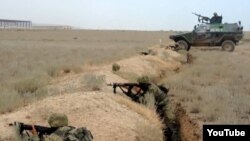Deadly skirmishes have erupted recently between Azerbaijani and Armenian forces over the breakaway region of Nagorno-Karabakh, with each side blaming the other for the escalation in violence. Here are answers to five central questions about the conflict.
Why Are They Fighting?
Azerbaijan and Armenia have been at loggerheads for decades over the status of Nagorno-Karabakh, a mountainous region inhabited almost entirely by ethnic Armenians but which is located within Azerbaijan’s internationally recognized borders.
The Soviet government designated the territory an autonomous region within Soviet Azerbaijan in the 1920s. Under Moscow’s iron rule, violence between the Armenians and Azerbaijanis that predated their incorporation into the Soviet Union was kept largely in check.
But as the Soviet Union began to wobble in the late 1980s, simmering tensions boiled over into a six-year war after Nagorno-Karabakh sought to formally join Armenia. The region’s self-styled government declared unilateral independence in 1991, and an estimated 30,000 people died in the conflict before Russia brokered a cease-fire in 1994.
The territory occupies some 4,400 square kilometers of land, and Armenian forces control buffer zones surrounding the breakaway region.
Nagorno-Karabakh has maintained de facto autonomy since the cease-fire, while Azerbaijan maintains its claim to the region.
Internationally mediated negotiations by the Minsk Group co-chaired by France, Russia, and the United States and organized under the Organization for Security and Cooperation in Europe (OSCE) have failed to yield a resolution to the so-called frozen conflict.
Cross-border violence has remained constant in the two decades since the 1994 cease-fire but has not escalated into a full-scale war.
Why Is The Violence Flaring Up Now?
Circumstances surrounding the recent surge in violence over Nagorno-Karabakh remain in dispute.
Azerbaijan says 13 of its soldiers have been killed in recent days in clashes with what it calls “Armenian sabotage groups,” while the self-proclaimed government in Nagorno-Karabakh says several of its soldiers have been killed while repelling attacks by Azerbaijani units.
Nagorno-Karabakh’s self-styled ministry of defense said in an August 2 statement that Azerbaijani forces had made moves on Armenian positions, which an RFE/RL correspondent in the area said on August 2 had indeed come under fire.
The claims and counterclaims typically have a cyclical quality to them, said Thomas de Waal, a South Caucasus expert and a senior associate in the Russia and Eurasia Program at the Carnegie Endowment for International Peace.
“In general, these episodes have a logic where one side starts it, the other side decides to respond, and then after a few exchanges of incidents it’s very hard to know who is the aggressor and who is not, because both sides are really the aggressor, as it were,” he said.
Weather also seems to play a role, de Waal said, adding that the recent spike in casualties was preceded by other incidents over the previous months.
“That seems to be a pattern, that in the winter it’s much quieter when...everyone sort of just hunkers down in their trenches,” he said. “And in the spring and summer it gets worse."
What Are Each Side’s Claims?
Azerbaijan considers Nagorno-Karabakh an illegally occupied territory, noting that its self-declared government lacks international recognition.
Armenia, meanwhile, says that Nagorno-Karabakh has "no future as a part of Azerbaijan" and believes that the conflict must be resolved with the "recognition of the Nagorno-Karabakh people's right to self-determination."
That recognition would likely lead to independence or reunification with Armenia. The breakaway republic estimates that of its population of around 145,000, some 95 percent are ethnic Armenians.
What Are The Chances Of A Settlement?
The Minsk Group has called on the presidents of Azerbaijan and Armenia "to take immediate action to defuse tensions and respect the cease-fire agreement" and "resume as soon as possible negotiations on peaceful settlement of the conflict."
The two presidents met in November, but prospects for a resolution to the conflict are not promising, de Waal told RFE/RL.
"There is a document on the table," he said. "But there seems to be completely zero trust in each other and in the process at the moment. So there is sort of a shadow of a peace process, but it doesn’t have much content at the moment."
Russian Foreign Minister Sergei Lavrov said on August 4 that Russian President Vladimir Putin would hold talks with Armenian President Serzh Sarkisian and Azerbaijani President Ilham Aliyev in Sochi, Russia at the end of this week. He added that Putin would first speak to the leaders separately before trying to convene trilateral talks.
Novruz Mammadov, deputy head of Aliyev’s administration, however, said in an interview with Azerbaijan's ANS television channel on August 4 that there had been no decision on whether the Azerbaijani leader would travel to Sochi.
What Are The Chances of War?
Armenian Defense Minister Seiran Ohanian said on August 4 that despite the recent spate of violence, Yerevan does not believe the conflict will escalate into outright war.
"The situation at the front line remains tense.... But analyses of the recent days [show] that in a global context there are no grounds today for a large-scale war," Ohanian told journalists, according to Reuters.
De Waal echoed that opinion, saying that Azerbaijan is unlikely to launch a large-scale offensive. Baku “is not in a condition militarily” to undertake such a move and is also likely keeping an eye on Moscow’s role in the conflict, he added.
“It’s one thing to kind of have pinpricks," de Waal said. "And a little bit of instability suits them. But a major military offensive could blow back in their faces, particularly if the Armenian-Russian relations are a bit stronger, as it is at the moment."
The danger of a further escalation, however, remains and threatens a potential increase in casualties on the frontlines, up from the “two or three a month [that] we’ve been seeing over the last few years,” de Waal said.
“We’d suddenly see 20 a month. And that would be bad enough.”















